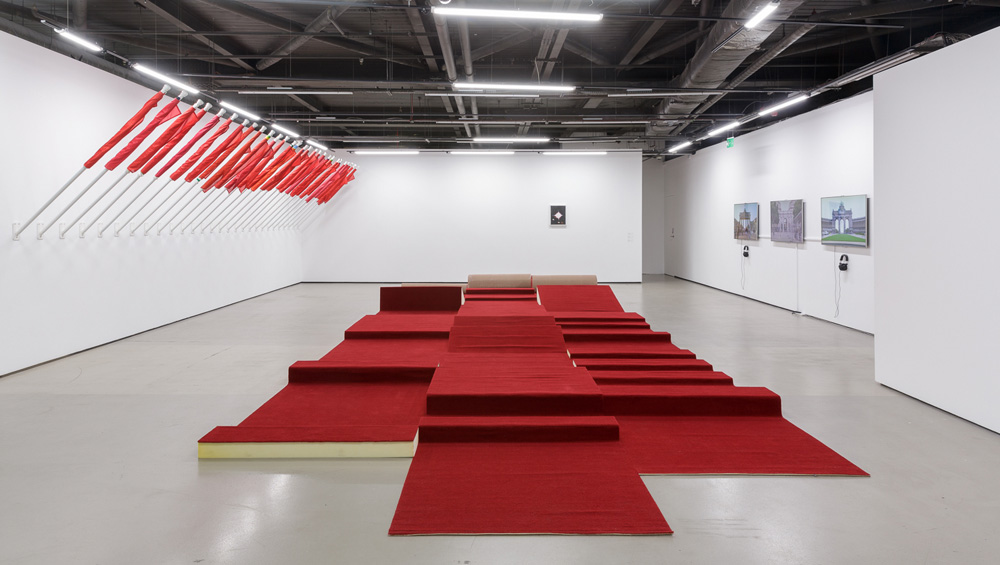
Korean Cultural Centre UK and Delfina Foundation, London
26 January – 16 March 2019
by HENRY BROOME
Spanning two institutions and assembling artists from across the world, Power Play not only deconstructs the nation state and the geopolitics of globalisation, but also exerts its power on visitors. The walk between the Korean Cultural Centre UK and the Delfina Foundation takes you under Admiralty Arch, once a navy high-command HQ, before sold to foreign investment and turned into a luxury hotel; then on to the Mall, the wide boulevard used for coronations and other royal ceremonies, which leads to Buckingham Palace, a grey and dour monument to the former might of Empire.
While the Delfina is tucked away in an Edwardian townhouse at the end of a quiet cul-de-sac, the KCCUK is set just off busy Trafalgar Square, where tourists from all over the world flock. From the outside, it looks like one of the many embassies in the surrounding area. You pass below the Korean flag at the door. Inside, the Polish artist Zuza Golińska’s Run-Up (2015) is installed in the main gallery. Three red carpets are rolled out across the length of the large space, calling to mind palace pageantry. But the carpets are moulded to foam underneath, cut into geometric objects, shaped like features of urban architecture – you can maybe make out kerbstones, steps and ramps – forms designed to subtly guide, repel and filter pedestrians and cars. Visitors can walk and relax on the carpet, but only, gallery staff tell you, if you agree to take off your shoes or wear covers, forcing visitors into the sort of trade-off written into the political theory of the social contract: the state promises citizens protection and equality under the rule of law, if in return they surrender certain freedoms and submit to the state’s authority. Hung across both spaces, Notice (2016) by Lantian Xie, from the United Arab Emirates, features a series of hand-drawn copies of English-Arabic signs from Dubai apartments. A seemingly polite request asking residents to use ashtrays ends, “YOUR IMMEDIATE COOPERATION IS NECESSARY”, reminding us that access to apparently open public space comes with (non-negotiable) rules.
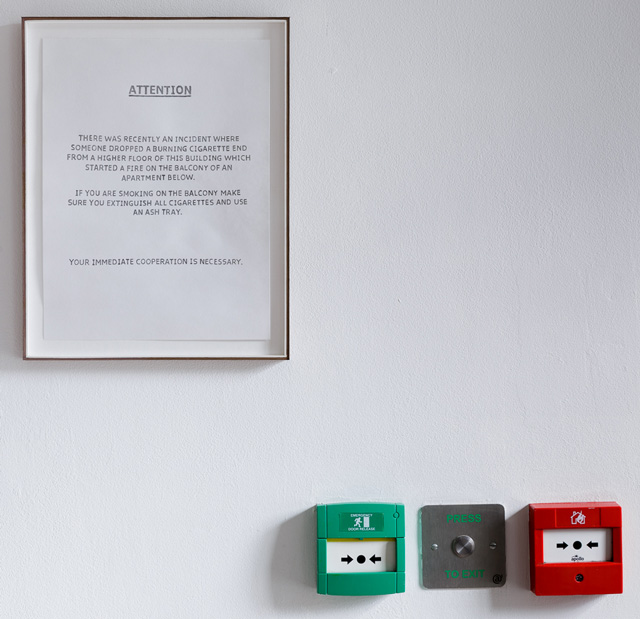
Notice (2016) by Lantian Xie, installation view, Power Play, 25 January - 16 March 2019. Photo: Tim Bowditch. Courtesy Delfina Foundation, Korean Cultural Centre UK, and SongEun ArtSpace.
The works of UK artist Jeremy Hutchison and South Korea’s Soyoung Chung understand the nation through borders, a state apparatus that not only defines its geographical limits but also controls the entry and exit of (non) nationals. Hutchison’s Movables (2017) references a photo taken at the moment border-patrol officers discovered a pair of stowaways hiding beneath the seat upholstery of a Mercedes, attempting to disguise themselves as part of the car.
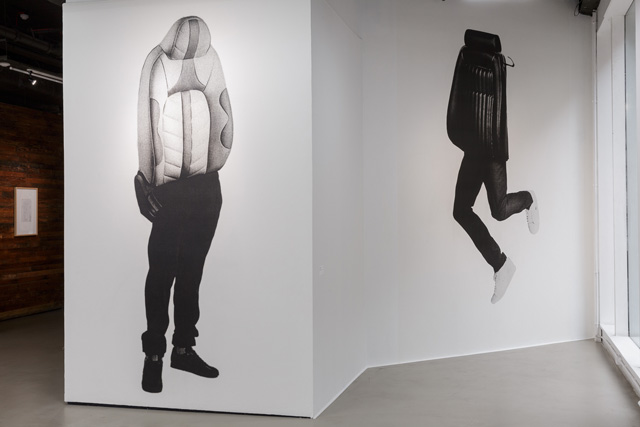
Jeremy Hutchison’s Movables (2017), installation view, Power play, 2019, 25 January - 16 March 2019. Photo: Tim Bowditch. Courtesy Delfina Foundation, Korean Cultural Centre UK, and SongEun ArtSpace.
Printed on commercial wallpaper and pasted on the walls of KCCUK like an advert, the work is a collage of various luxury, leather-clad car seats and the lower half of clothing models, critiquing the way the people-trafficking trade turns the desperate into saleable commodities, also calling to the mind the low-wage, exported labour that fashion retailers exploit. Across at the Delfina, Chung’s sculpture Island for Fisherman (2018) comprises buoys the artist found, originating from the Korea-China area, strung together by plaited bronze cable. The wire bends up off the ground, suspending the middle buoy in the air, referencing the ever-shifting borders that mark fish farmers’ catchment areas, while, at the same time, conjuring the strange floating feeling the visitor experiences when navigating, and thinking back on, an exhibition spanning two disparate galleries.
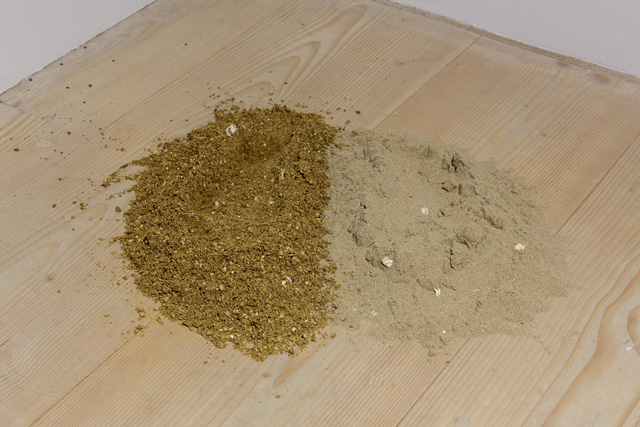
Oscar Santillán’s Cuerpo de Agua (2018), installation view, Power play, 2019, 25 January - 16 March 2019. Photo: Tim Bowditch. Courtesy Delfina Foundation, Korean Cultural Centre UK, and SongEun ArtSpace.
As a counterpoint to the previous two installations, the Ecuadorean artist Oscar Santillán’s Cuerpo de Agua (2018) interrogates notions of national identity defined by geography, rooted in the land. The work of the artist, who is now based in the Netherlands, developed out of trans-oceanic contact theories, the idea that people from Asia and elsewhere travelled to the Americas before European settlers. Two footsteps (from complete strangers) are printed in piles of sand collected from opposite sides of the Pacific Ocean. The image of a trans-pacific body politic with one foot on either side of the ocean not only disrupts colonial history, but also gives hope to a deterritorialised, transnational model of citizenship. The parameters of states are constantly shifting, Cuerpo de Agua tells us. They are not fixed, self-contained entities.
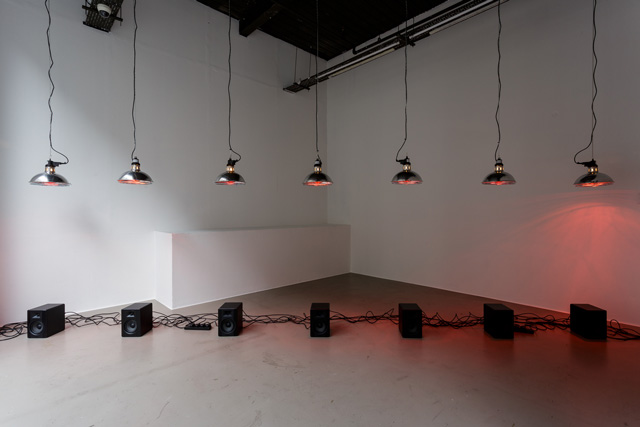
Power play, 2019, installation view, 25 January - 16 March 2019. Photo: Tim Bowditch. Courtesy Delfina Foundation, Korean Cultural Centre UK, and SongEun ArtSpace.
The South Korean artist Jungki Beak’s audio-visual installation observes the way countries retroactively construct cultural-political identities. Memorial Antenna (Archive) (2018) forms a record of a continuing project that started in 2011. The artist transforms various international monuments into antennas for receiving radio signals. We see equestrian statues, decommissioned tanks, even bridges hooked up to laptops and loudspeakers. Photos of a bust of the runner Sohn Kee-Chung are paired with an audio track featuring a crackly recording of a sermonising Japanese voice. Sohn was the first Korean athlete to win an Olympic medal, taking gold at the 1936 Berlin games (but as part of a Japanese delegation because Korea was under colonial rule at the time). The bust and memorial park built in Seoul therefore represents an attempt to lay claim retroactively to the victory and assert Korean pride in the face of an old foreign imperialism. When debate continues about whether Oxford’s Cecil Rhodes statue and other monuments should be taken down, Beak reminds us that they are not simply records of an objective history, but preserve and produce readings of the past that actively shape public discourse and, in turn, inform national policy.
Today, though, globalisation poses significant threats to the preservation of national identities. Envelopments (2010), from the Algerian-born, French-based artist Fayçal Baghriche, sets out a dominating display of 28 wall-mounted national flags, wrapped around poles and encased in red fabric, invoking the cultural uniformity produced by international trade. Elsewhere, the video The Stopper I (2018), by Beak and the German-based Dutch artist Jasmijn Visser, features a live audiovisual stream of a dripping tap in Beak’s flat in Seoul. As the water slaps against the steel sink, exactly once every second, it produces a monotonous record of the passing of time, emphasising that clocks tick at the same rate the world over. We may live in different time zones, but global communication never sleeps.
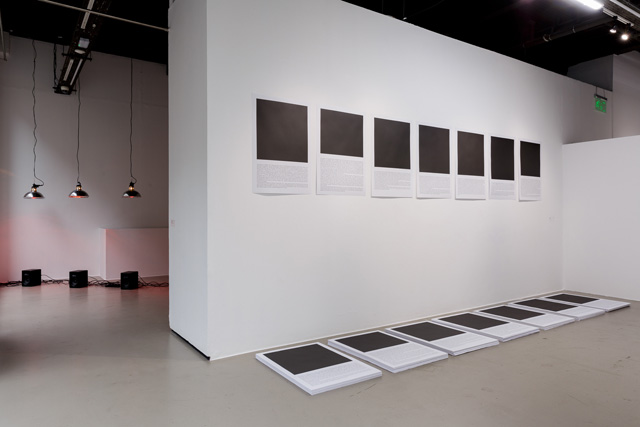
Power play, 2019, installation view, 25 January - 16 March 2019. Photo: Tim Bowditch. Courtesy Delfina Foundation, Korean Cultural Centre UK, and SongEun ArtSpace.
The global economy, always active, has driven an unsustainable level of production, edging us ever closer to the abyss of ecological collapse we see in Bona Park’s installation Black Square (2013). A series of seven posters features descriptions of recently extinct species, below an eerie black square – what can’t be pictured now. They are each printed 200 times – one pinned to the wall, the rest piled up on the floor for visitors to take as souvenirs. A jar of elastic bands to the side slyly invites visitors to feed their materialist desires. But the more the posters disappear, the nearer, it seems, is Earth’s extinction.
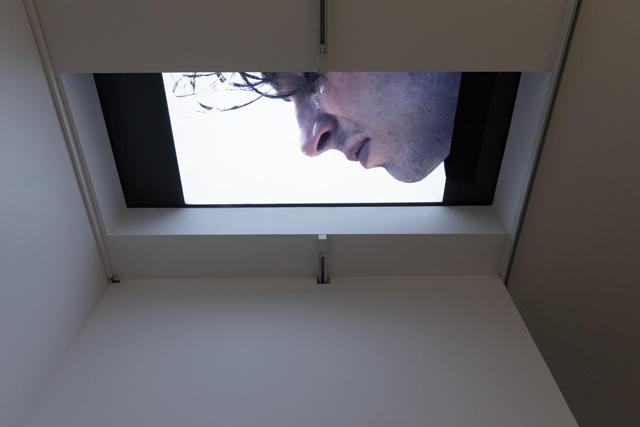
Power play, 2019, installation view, 25 January - 16 March 2019. Photo: Tim Bowditch. Courtesy Delfina Foundation, Korean Cultural Centre UK, and SongEun ArtSpace.
To avert disaster, we need perhaps to reconfigure our relationship not just with animals and our environment but with other humans, too. Santillán’s video work, The Telepathy Manifesto (2011), screened on a monitor installed in the ceiling, depicts a man leaning over the edge of a motorway flyover. He looks distraught. Tears drip from his face to another man’s down on the ground. Perhaps it is the empathy in this image that may help us collectively to transcend politico-economic interests.